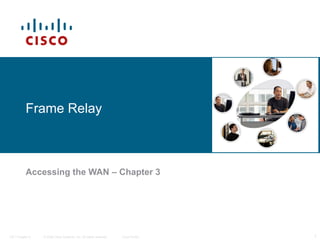
Chapter 3 frame relay
- 1. Frame Relay Accessing the WAN – Chapter 3 ITE I Chapter 6 © 2006 Cisco Systems, Inc. All rights reserved. Cisco Public 1
- 2. Objectives Describe the fundamental concepts of Frame Relay technology in terms of Enterprise WAN services including Frame Relay operation, Frame Relay implementation requirements, Frame Relay maps, and LMI operation. Configure a basic Frame Relay PVC including configuring and troubleshooting Frame Relay on a router serial interface and configuring a static Frame Relay map. Describe advanced concepts of Frame Relay technology in terms of Enterprise WAN services including Frame Relay sub- interfaces, Frame Relay bandwidth and flow control. Configure an advanced Frame Relay PVC including solving reachability issues, configuring Frame Relay sub-interfaces, verifying and troubleshooting Frame Relay configuration. ITE 1 Chapter 6 © 2006 Cisco Systems, Inc. All rights reserved. Cisco Public 2
- 3. Describe the Fundamental Concepts of Frame Relay Technology Describe how Frame Relay is used to provide WAN services to the Enterprise ITE 1 Chapter 6 © 2006 Cisco Systems, Inc. All rights reserved. Cisco Public 3
- 4. Describe the Fundamental Concepts of Frame Relay Technology Describe how Frame Relay uses virtual circuits to carry packets from one DTE to another ITE 1 Chapter 6 © 2006 Cisco Systems, Inc. All rights reserved. Cisco Public 4
- 5. Describe the Fundamental Concepts of Frame Relay Technology Explain how Frame Relay encapsulation works ITE 1 Chapter 6 © 2006 Cisco Systems, Inc. All rights reserved. Cisco Public 5
- 6. Describe the Fundamental Concepts of Frame Relay Technology Describe the types of topologies that are used for implementing Frame Relay in different environments ITE 1 Chapter 6 © 2006 Cisco Systems, Inc. All rights reserved. Cisco Public 6
- 7. Describe the Fundamental Concepts of Frame Relay Technology Describe how a router attached to a Frame Relay network uses LMI status messages and inverse ARP queries to map VCs to layer 3 network IP Addresses ITE 1 Chapter 6 © 2006 Cisco Systems, Inc. All rights reserved. Cisco Public 7
- 8. Configure a Basic Frame Relay PVC Configure a basic Frame Relay PVC on a router serial interface ITE 1 Chapter 6 © 2006 Cisco Systems, Inc. All rights reserved. Cisco Public 8
- 9. Configure a Basic Frame Relay PVC Configure a static Frame Relay map ITE 1 Chapter 6 © 2006 Cisco Systems, Inc. All rights reserved. Cisco Public 9
- 10. Describe Advanced Concepts of Frame Relay Technology Explain the reachability issues associated with the Frame Relay NBMA topology ITE 1 Chapter 6 © 2006 Cisco Systems, Inc. All rights reserved. Cisco Public 10
- 11. Describe Advanced Concepts of Frame Relay Technology Describe how to implement bandwidth control in the Frame Relay technology ITE 1 Chapter 6 © 2006 Cisco Systems, Inc. All rights reserved. Cisco Public 11
- 12. Describe Advanced Concepts of Frame Relay Technology Describe how to implement flow control in Frame Relay technology ITE 1 Chapter 6 © 2006 Cisco Systems, Inc. All rights reserved. Cisco Public 12
- 13. Configure an Advanced Frame Relay PVC Explain the steps to configure point-to-point subinterfaces on a physical interface ITE 1 Chapter 6 © 2006 Cisco Systems, Inc. All rights reserved. Cisco Public 13
- 14. Configure an Advanced Frame Relay PVC Describe the commands used for verifying Frame Relay operation ITE 1 Chapter 6 © 2006 Cisco Systems, Inc. All rights reserved. Cisco Public 14
- 15. Configure an Advanced Frame Relay PVC Describe the steps for troubleshooting a Frame Relay configuration ITE 1 Chapter 6 © 2006 Cisco Systems, Inc. All rights reserved. Cisco Public 15
- 16. Summary Frame relay is the most widely used WAN technology because it: –Provides greater bandwidth than leased line –Reduces cost because it uses less equipment –Easy to implement Frame relay is associated with layer 2 of the OSI model and encapsulates data packets in a frame relay frame Frame relay is configured on virtual circuits –These virtual circuits may be identified by a DLCI Frame relay uses inverse ARP to map DLCI to IP addresses ITE 1 Chapter 6 © 2006 Cisco Systems, Inc. All rights reserved. Cisco Public 16
- 17. Summary Configuring frame relay requires –Enable frame relay encapsulation –Configuring either static or dynamic mapping –Considering split horizon problems that develop when multiple VCs are placed on a single physical interface Factor affecting frame relay configuration –How service provider has their charging scheme set up Frame relay flow control –DE –FECN –BECN ITE 1 Chapter 6 © 2006 Cisco Systems, Inc. All rights reserved. Cisco Public 17
- 18. Summary The following commands can be used to help verify frame relay configuration –Show interfaces –Show frame-relay lmi –Show frame-relay pvc ### –Show frame-relay map Use the following command to help troubleshoot a frame relay configuration –Debug frame-relay lmi ITE 1 Chapter 6 © 2006 Cisco Systems, Inc. All rights reserved. Cisco Public 18
- 19. ITE 1 Chapter 6 © 2006 Cisco Systems, Inc. All rights reserved. Cisco Public 19
Notas del editor
- Graphic 3.1.1.1 (frame relay)
- Graphic 3.1.2.1 Graphic 3.1.2.2
- Graphic 3.1.3.1
- Graphic 3.1.4.1 Graphic 3.1.4.2
- Graphic 3.1.5.4
- Graphic 3.2.1.1 & 3.2.1.2
- Graphic 3.2.2.1
- Graphic 3.3.1.1
- Graphic 3.3.2.1 & 3.3.2.2
- Graphic 3.3.3.1
- Graphic 3.4.1.2
- Graphic 3.4.2.1
- Graphic 3.4.3.1
